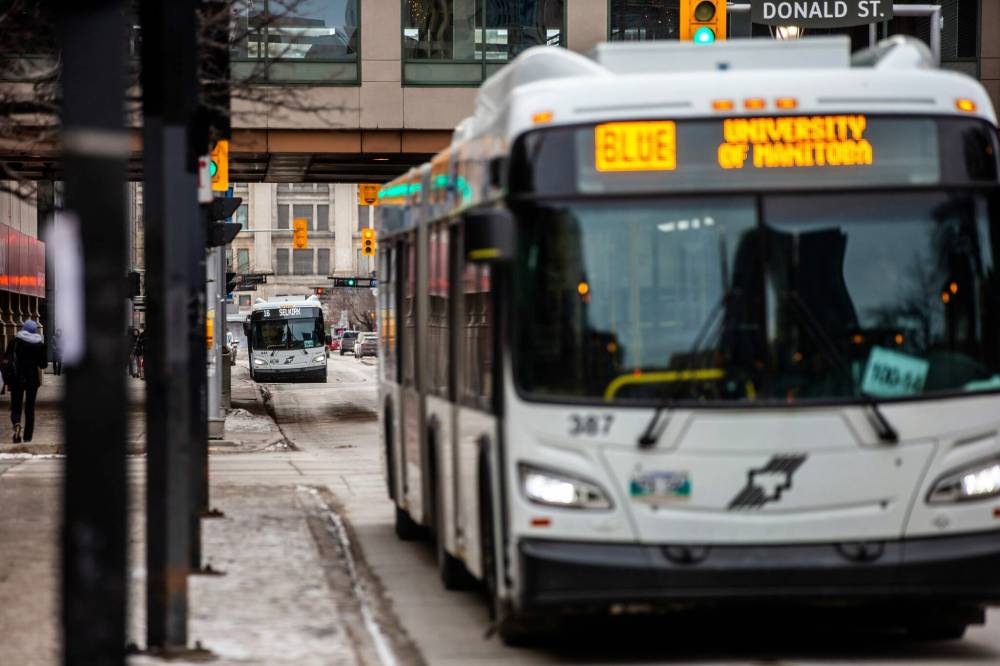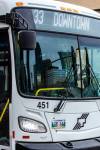Transit deserves more support than it gets
Advertisement
Read this article for free:
or
Already have an account? Log in here »
To continue reading, please subscribe:
Monthly Digital Subscription
$0 for the first 4 weeks*
- Enjoy unlimited reading on winnipegfreepress.com
- Read the E-Edition, our digital replica newspaper
- Access News Break, our award-winning app
- Play interactive puzzles
*No charge for 4 weeks then price increases to the regular rate of $19.00 plus GST every four weeks. Offer available to new and qualified returning subscribers only. Cancel any time.
Monthly Digital Subscription
$4.75/week*
- Enjoy unlimited reading on winnipegfreepress.com
- Read the E-Edition, our digital replica newspaper
- Access News Break, our award-winning app
- Play interactive puzzles
*Billed as $19 plus GST every four weeks. Cancel any time.
To continue reading, please subscribe:
Add Free Press access to your Brandon Sun subscription for only an additional
$1 for the first 4 weeks*
*Your next subscription payment will increase by $1.00 and you will be charged $16.99 plus GST for four weeks. After four weeks, your payment will increase to $23.99 plus GST every four weeks.
Read unlimited articles for free today:
or
Already have an account? Log in here »
Hey there, time traveller!
This article was published 29/12/2023 (694 days ago), so information in it may no longer be current.
The wheels on the bus go round and round, and so do the problems and perceptions that plague Winnipeg Transit.
Both facts became apparent once again when the Free Press tagged along with Mayor Scott Gillingham on the No. 11 bus for his commute from Polo Park to city hall as part of a series of stories that serve to convey the state of Winnipeg Transit.
It’s a sorry state, and the challenges go far beyond a recent Probe poll finding that only 12 per cent of Winnipeggers use the bus.

Winnipeg Transit ridership plummeted in 2020 owing to the COVID-19 pandemic, but usage has since risen to 91 per cent of its 2019 level, the city agency announced in October.
However, it has cut its services by five per cent because of a driver shortage which has led to sudden route disruptions, lengthened waits at bus stops and overcrowding on the city’s most used routes.
Violence on buses has deterred drivers and riders alike from taking the bus. There were 104 assaults on drivers reported in 2022, the highest number since 2000.
While Gillingham said during his commute that thousands of Winnipeggers use Transit every day without incident, the Probe poll found safety should be the top priority to improve Winnipeg’s bus service.
Winnipeg isn’t the only city that has a perception problem with regards to public-transit safety, but changing public beliefs is an uphill battle.
When motorists drive by vandalized bus shelters or ones occupied by the homeless, it only confirms their decision that it’s too risky to take Winnipeg Transit to get where they want to go.
Changing their minds by creating a safer bus service will be costly, whether the city chooses to install security cameras, hire extra police or security guards to patrol buses or a combination of both.
Raising fares, like the city will do Jan. 1 when the cost of boarding a Transit bus rises 10 cents to $3.25, also deters ridership, and empty buses add to the safety issue.
“The more people ride the system regularly, the more they will feel comfortable — that’s strength in numbers,” Tim Scott, general manager for a company tasked with improving security on St. Louis’s Metrolink transit system, told the Free Press.
Raising fares and cutting routes has done the opposite of creating a more efficient and safer service and only hampers those who have no other option than Winnipeg Transit to get around the city.
It also raises another barrier for motorists to give Transit a try, a group who will be emboldened to keep on trucking when the provincial government pauses the collection of its 14-cent-per-litre fuel tax for six months, beginning Jan. 1.
Many of those motorists will gladly accept the NDP’s election goodie, yet be quick to criticize any potential funding increases to improve bus service, failing to realize most North American cities, Winnipeg included, subsidize automobile users to a far greater extent than public transit.
It’s a gap that broadens with every widened street, such as the proposed expansion of Kenaston Boulevard, and every new road, such as the Chief Peguis Trail expansion, projects estimated to cost $1 billion combined.
Until Winnipeg Transit receives a fraction of that economic and political commitment to improve the safety and reliability of its service, it will continue spinning its wheels with regards to long-standing problems and perceptions about safety, reliability and cost.

















